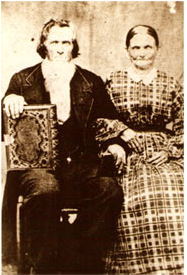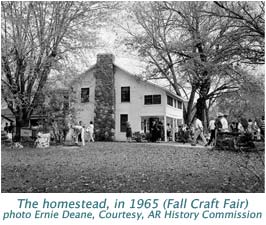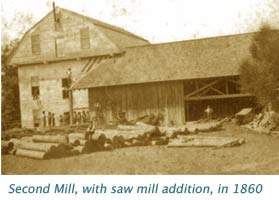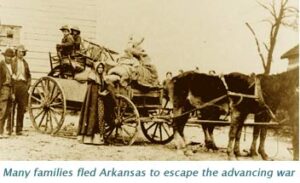WAR EAGLE MILL HISTORY SINCE 1832
War Eagle Mill’s exciting history begins with the story of a tenacious pioneer couple, Sylvanus and Catherine Blackburn, who understood the importance of fresh, natural food in the lives of families as far back as 1832 when the first Mill was built.
A HOMESTEAD IN A LUSH VALLEY
 Sylvanus was 16 years old when he married Catherine. The young couple lived on his parent’s farm in Tennessee for a year but then decided it was time to find a place of their own. Sylvanus left Catherine with his folks and headed west. He didn’t stop until he came upon a lush valley next to the War Eagle Creek in Arkansas. Sylvanus had found the most beautiful setting for their new home and immediately sent for Catherine so they could begin their life in the War Eagle Valley. The first thing Sylvanus and Catherine did was build a house using wood from the surrounding forest. It sat on top of the little hill next to the creek and was so well built that it is still in use today.
Sylvanus was 16 years old when he married Catherine. The young couple lived on his parent’s farm in Tennessee for a year but then decided it was time to find a place of their own. Sylvanus left Catherine with his folks and headed west. He didn’t stop until he came upon a lush valley next to the War Eagle Creek in Arkansas. Sylvanus had found the most beautiful setting for their new home and immediately sent for Catherine so they could begin their life in the War Eagle Valley. The first thing Sylvanus and Catherine did was build a house using wood from the surrounding forest. It sat on top of the little hill next to the creek and was so well built that it is still in use today.
After the house was completed, the couple turned their attention to planting corn in the fertile bottomlands of the creek valley. But with the closest mill to grind their corn being located in Richand, 25 miles away, the Blackburns quickly recognized the need for a gristmill. The War Eagle Creek would provide the perfect energy source to grind grain into flour. It didn’t take long for the surrounding neighbors to bring their own corn to Sylvanus for grinding, and a community was built around all that the mill had to offer.
In 1848, a heavy rainy season flooded the entire valley, and the mill was pushed into the river, washed downstream, and was totally destroyed. As soon as the water receded, Sylvanus and Catherine were determined to rebuild the mill. They expanded the structure to mill lumber in addition to milling grain.
THE CIVIL WAR COMES TO THE OZARKS
In 1861, the Civil War broke out. Many Northwest Arkansas residents were caught between strongly Confederate Arkansans to the south and Union-supporting Missourians only a few miles away to the north.
 Five of the Blackburn’s sons enlisted in the Confederate Army, while Sylvanus and Catherine decided to take the rest of their children to Texas to ride out the conflict. Sylvanus left behind his entire life’s work and his beloved mill to protect his family. It would be nearly four years before any of them would return to the War Eagle river valley.
Five of the Blackburn’s sons enlisted in the Confederate Army, while Sylvanus and Catherine decided to take the rest of their children to Texas to ride out the conflict. Sylvanus left behind his entire life’s work and his beloved mill to protect his family. It would be nearly four years before any of them would return to the War Eagle river valley.
In 1862, the Union Army moved into northern Arkansas and the War Eagle Valley and used the mill to grind grain for food. When the Union soldiers heard that the Confederate Army was advancing into the area, they picked up and went to Pea Ridge, Arkansas. For two days, the Confederate soldiers used the mill, but their military position was so unstable that a Confederate general ordered that the Mill be burned to the ground to prevent it from being used again by the Union. Chaos ensued after the horrific Battle of Pea Ridge, and the entire county and surrounding areas were laid waste by the retreating Confederates and bands of looters. Fayetteville and Bentonville would be the first U.S. cities to be destroyed by fire during the war. With crops destroyed and the Mill in ashes, food shortages would force many residents to abandon their homesteads and flee.
REBUILDING FOR THE THIRD TIME
 After the war ended in 1865, Sylvanus and his family returned to find their house still standing, but the mill was gone again. This time, it would be Sylvanus’ son, James Austin Cameron (J. A. C.) Blackburn, who would take on the task of reconstructing the Mill. The reconstruction of the Mill was finished in 1873.
After the war ended in 1865, Sylvanus and his family returned to find their house still standing, but the mill was gone again. This time, it would be Sylvanus’ son, James Austin Cameron (J. A. C.) Blackburn, who would take on the task of reconstructing the Mill. The reconstruction of the Mill was finished in 1873.
- A. C. decided to expand Mill production by adding a more powerful grinding machine run by a turbine engine instead of a water wheel. The Mill grew even more prosperous. Their sawmill, reportedly the largest in Arkansas, led J. A. C. to become known as the “Lumber King” of northwest Arkansas. Lumber cut at the War Eagle sawmill was used to build much of Fayetteville, AR – including Old Main on the University of Arkansas campus.
The Mill was operational until 1924 when it burned down for the second time, by a fire of unknown cause. This fire left only the foundation and remnants of the building.
REBORN FROM THE ASHES – THE MODERN MILL
 In 1973, Mr. Jewel Medlin purchased the property, intrigued by the old mill foundation and its rich history. Jewel, his wife Leta, and daughter Zoe Medlin Caywood, searched and found blueprints for the third mill and took on the task of rebuilding it for the fourth time!
In 1973, Mr. Jewel Medlin purchased the property, intrigued by the old mill foundation and its rich history. Jewel, his wife Leta, and daughter Zoe Medlin Caywood, searched and found blueprints for the third mill and took on the task of rebuilding it for the fourth time!
The design was modified slightly to bring back the undershot waterwheel that Sylvanus had used over 100 years earlier.
That is the same waterwheel system that has powered the mill from 1973 to today. War Eagle Mill is the only working mill in Arkansas, and it is still powered by an eighteen-foot cypress waterwheel. We believe it to be the only undershot water wheel currently in operation in the United States.
Owned by Elise Roenigk since 2004, the Mill continues to focus on the same high-quality, healthy organic products.
